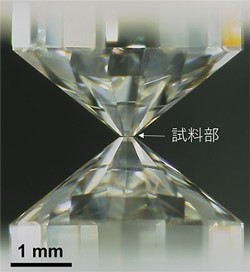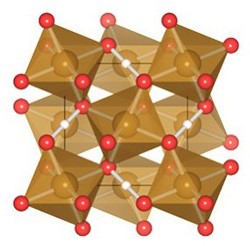News
Ehime University and Others Find Hydrous Mineral with New Structure: Water May Be Transported Deep Into the Mantle Updated in August 2017
Research group consisting of Ehime University Geodynamics Research Center (GRC) and others announced that water stored in the interior of our earth as rockstones are transported much deeper into the inner core of the earth than previously estimated. The research discovered “iron hydroxide,” a crystalline-structure which can transport water to the inner mantle of the earth even under immensely high pressure. This paper was recently published in Nature. The group has high hopes that this discovery shall help in understanding circulation of water in the earth core. Details are still unknown but large amounts of water are predicted to exist at the core of the earth.
From its outer surface, the earth can be divided into several layers: the crust, the mantle, and the nucleus (outer core and inner core). Plates forming the seabed are parts of earth’s crust and are also called "oceanic plates." When these oceanic plates sink or “subduct” into the mantle through plate movements, they are thought to bring in large amounts of sea water. According to the group, in such “subduction” zones, the ocean plate, rocks and water react with each other from typically high pressure and high temperature. Such conditions produce large amounts of hydrous minerals.
Conventionally, hydrous minerals were thought to dehydrate and decompose under immense pressure in the mantle. For instance, iron hydroxide which consists of iron and hydrogen was thought to decompose from dehydration at around 800,000 atm when it sank 1,900 kilometers deep into the mantle.
Research scientists Masayuki Nishi and Yasuhiro Kuwayama (University of Tokyo, School of Science), Associate Professor Jun Tsuchiya, and Professor Taku Tsuchiya of GRC first used the supercomputer “K” to conduct theoretical calculation of the iron hydroxide’s crystalline structure. At 800,000 atm, iron hydroxide did not decompose from dehydration but transformed into a Pyrite-type crystalline structure.
In view of these results, the group applied high pressure to the iron hydroxide equivalent to that of the inner mantle. The mineral turned into a Pyrite-type crystalline structure and water was found in the structure. Pyrite-type is known as a high-density structure. The iron hydroxide found this time is said to be one of the most high-density hydrous mineral ever found.
In the experiment, the iron hydroxide with Pyrite-type crystalline structure managed to preserve its structure even under pressure of 1,400,000 atm. From this, Dr. Nishi and his team conclude that at 1,400,000 atm which is equivalent to a depth of 2900 km deep into the innermost mantle, Pyrite-type iron hydroxide may not dehydrate and decompose, but would keep transporting water. These findings overturn conventional academic theory which states that hydrous minerals would decompose by dehydration at 1,900 atm.
According to the group, 70 percent of the earth is covered by sea water but the mass of water which can be stored at the earth core is several times more than that. Not only does water exist on earth’s surface but it is a vital element that can greatly affect the evolution of our earth. The iron hydroxide possessing a new structure can survive under extremely high pressure found at boundaries between the earth’s mantle and the nucleus. Iron hydroxides are estimated to greatly influence movements within the inner earth. They affect mantle elevation at mantle-nucleus boundaries, and can also affect circulation of water at the earth core.
Laser-heated diamond anvil cells, which is a device to apply ultra-high pressure and synchrotron radiation from the large-scale light emitting facility Spring-8 were used in this research experiment.
End of translation
http://grc.ehime-u.ac.jp/en/


Note: Arrow pointed section shows sample

Note: Large/Brown-Iron atom; Midsized/Red-Oxygen atom; Small/Light Pink-Hydrogen atom







